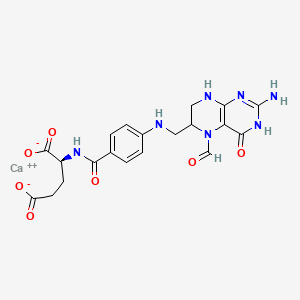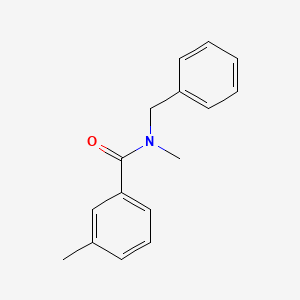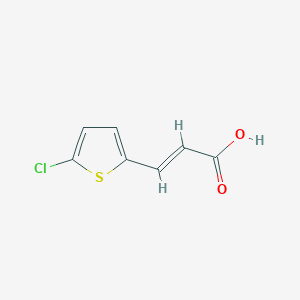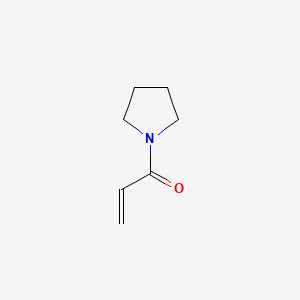
CID 135738681
- Click on QUICK INQUIRY to receive a quote from our team of experts.
- With the quality product at a COMPETITIVE price, you can focus more on your research.
Overview
Description
The compound with the identifier “CID 135738681” is a chemical entity listed in the PubChem database. It is characterized by its unique molecular structure and properties, which make it of interest in various scientific fields.
Preparation Methods
Synthetic Routes and Reaction Conditions
The preparation of CID 135738681 involves specific synthetic routes. One such method includes reacting 2-fluoro-4-substituted phenylacetic acid with a Vilsmeier reagent, followed by quenching the reaction solution in an aqueous solution to obtain an intermediate . This intermediate is then further processed to yield the final compound.
Industrial Production Methods
Industrial production methods for this compound typically involve large-scale synthesis using optimized reaction conditions to ensure high yield and purity. The exact details of these methods are often proprietary and may vary between manufacturers.
Chemical Reactions Analysis
Types of Reactions
CID 135738681 undergoes various chemical reactions, including:
Oxidation: This reaction involves the addition of oxygen or the removal of hydrogen.
Reduction: This reaction involves the addition of hydrogen or the removal of oxygen.
Substitution: This reaction involves the replacement of one atom or group of atoms with another.
Common Reagents and Conditions
Common reagents used in these reactions include oxidizing agents like potassium permanganate, reducing agents like lithium aluminum hydride, and various nucleophiles for substitution reactions. The conditions for these reactions typically involve controlled temperatures and pH levels to ensure the desired outcome.
Major Products
The major products formed from these reactions depend on the specific reagents and conditions used. For example, oxidation may yield carboxylic acids, while reduction may produce alcohols.
Scientific Research Applications
CID 135738681 has a wide range of applications in scientific research:
Chemistry: It is used as a reagent in various organic synthesis reactions.
Biology: It serves as a tool for studying biochemical pathways and molecular interactions.
Medicine: It is investigated for its potential therapeutic effects and as a lead compound in drug development.
Industry: It is utilized in the production of specialty chemicals and materials.
Mechanism of Action
The mechanism of action of CID 135738681 involves its interaction with specific molecular targets and pathways. It may bind to enzymes or receptors, modulating their activity and leading to various biological effects. The exact molecular targets and pathways can vary depending on the context of its use.
Comparison with Similar Compounds
Similar Compounds
Similar compounds to CID 135738681 include other fluorinated phenylacetic acid derivatives and related chemical entities. These compounds share structural similarities but may differ in their specific functional groups and properties.
Uniqueness
What sets this compound apart from similar compounds is its unique combination of functional groups and molecular structure, which confer specific reactivity and biological activity. This uniqueness makes it a valuable compound for targeted research and applications.
Conclusion
This compound is a versatile compound with significant importance in various scientific fields. Its unique properties and reactivity make it a valuable tool for research and industrial applications.
Properties
CAS No. |
41927-89-3 |
|---|---|
Molecular Formula |
C20H31CaN7O12 |
Molecular Weight |
601.6 g/mol |
IUPAC Name |
calcium;(2S)-2-[[4-[(2-amino-5-formyl-4-oxo-3,6,7,8-tetrahydropteridin-6-yl)methylamino]benzoyl]amino]pentanedioate;pentahydrate |
InChI |
InChI=1S/C20H23N7O7.Ca.5H2O/c21-20-25-16-15(18(32)26-20)27(9-28)12(8-23-16)7-22-11-3-1-10(2-4-11)17(31)24-13(19(33)34)5-6-14(29)30;;;;;;/h1-4,9,12-13,22H,5-8H2,(H,24,31)(H,29,30)(H,33,34)(H4,21,23,25,26,32);;5*1H2/q;+2;;;;;/p-2/t12?,13-;;;;;;/m0....../s1 |
InChI Key |
NPPBLUASYYNAIG-ZIGBGYJWSA-L |
SMILES |
C1C(N(C2=C(N1)N=C(NC2=O)N)C=O)CNC3=CC=C(C=C3)C(=O)NC(CCC(=O)O)C(=O)O.O.O.O.O.O.[Ca] |
Isomeric SMILES |
C1C(N(C2=C(N1)N=C(NC2=O)N)C=O)CNC3=CC=C(C=C3)C(=O)N[C@@H](CCC(=O)[O-])C(=O)[O-].O.O.O.O.O.[Ca+2] |
Canonical SMILES |
C1C(N(C2=C(N1)N=C(NC2=O)N)C=O)CNC3=CC=C(C=C3)C(=O)NC(CCC(=O)[O-])C(=O)[O-].O.O.O.O.O.[Ca+2] |
Related CAS |
58-05-9 (Parent) |
solubility |
DMSO « 1 (mg/mL) H2O 100 (mg/mL) 0.1 N NaOH < 20 (mg/mL) |
Origin of Product |
United States |
Retrosynthesis Analysis
AI-Powered Synthesis Planning: Our tool employs the Template_relevance Pistachio, Template_relevance Bkms_metabolic, Template_relevance Pistachio_ringbreaker, Template_relevance Reaxys, Template_relevance Reaxys_biocatalysis model, leveraging a vast database of chemical reactions to predict feasible synthetic routes.
One-Step Synthesis Focus: Specifically designed for one-step synthesis, it provides concise and direct routes for your target compounds, streamlining the synthesis process.
Accurate Predictions: Utilizing the extensive PISTACHIO, BKMS_METABOLIC, PISTACHIO_RINGBREAKER, REAXYS, REAXYS_BIOCATALYSIS database, our tool offers high-accuracy predictions, reflecting the latest in chemical research and data.
Strategy Settings
| Precursor scoring | Relevance Heuristic |
|---|---|
| Min. plausibility | 0.01 |
| Model | Template_relevance |
| Template Set | Pistachio/Bkms_metabolic/Pistachio_ringbreaker/Reaxys/Reaxys_biocatalysis |
| Top-N result to add to graph | 6 |
Feasible Synthetic Routes
Disclaimer and Information on In-Vitro Research Products
Please be aware that all articles and product information presented on BenchChem are intended solely for informational purposes. The products available for purchase on BenchChem are specifically designed for in-vitro studies, which are conducted outside of living organisms. In-vitro studies, derived from the Latin term "in glass," involve experiments performed in controlled laboratory settings using cells or tissues. It is important to note that these products are not categorized as medicines or drugs, and they have not received approval from the FDA for the prevention, treatment, or cure of any medical condition, ailment, or disease. We must emphasize that any form of bodily introduction of these products into humans or animals is strictly prohibited by law. It is essential to adhere to these guidelines to ensure compliance with legal and ethical standards in research and experimentation.
















